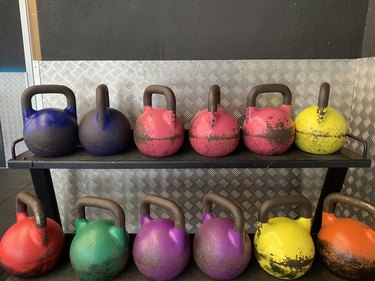
There's probably no better representation of the "weight lifting makes you bulky" myth than that classic Planet Fitness ad in which the bodybuilder repeatedly tells the uncomfortable gym attendant, "I lift things up and put them down."
Weight lifting builds muscle, sure. But it can also help you lose weight and, yes, look leaner in the process.
Video of the Day
Video of the Day
So what about that other age-old adage, that muscle weighs more than fat? Well, a pound is a pound either way. But there are a few key differences between muscle and fat that are definitely helpful to understand. More on that in a minute.
Here's what you need to know weight lifting to lose weight — aka lifting things up to make the scale go down.
Lifting Weight to Lose Weight
Weight loss can be difficult in practice, but weight-loss success really comes down to a simple equation: You need to burn more calories than you consume.
One pound of fat is equal to about 3,500 calories, according to a September 2014 paper in JAMA, so if you burn about 500 calories a day, you could potentially drop a pound a week. According to Harvard Health Pubishing, a 155-pound person can burn 446 calories after 60 minutes of lifting free weights, and a 185-pound person can burn 532 calories.
Research shows that your body continues to burn calories after a lifting workout: The lean muscle mass you build from weight lifting will speed up your resting metabolism.
"This means that hours after your workout — and sometimes even days after — your body will continue burning calories," Lais DeLeon, a fitness coach and Plankk Studio trainer, tells LIVESTONG.com.
While other workouts like cardio certainly have their benefits (stress relief and heart health, among others), they burn calories in the moment. Weight lifting is special because of its after-burn benefits (and hey, who doesn't want more burn for your buck?).
Lifting weights can also improve your body composition. When the number on the scale decreases, you're usually losing a combination of body fat, water and muscle, DeLeon explains, but resistance training is more effective than cardio at helping you preserve muscle, which lends you a more toned look. "You're more likely to burn body fat, instead of muscle, when you lift weights," she says.
Doesn't Muscle Weigh More Than Fat, Though?
Here's the thing: Muscle is denser than fat, according to The Social & Health Research Center, meaning it's heavier by volume but takes up less space. Think about the difference between a pound of iron vs. a pound of feathers. They weigh the same (a pound), but the iron can easily fit in your hand, while you'd need a bucket to contain all the feathers.
Muscle takes up about four-fifths as much space as fat, so the difference isn't huge. But if you take two people who are the same height and weight, the one with a higher body fat percentage will likely wear a larger clothing size.
Wondering if your body fat percentage is in a healthy range? Use the LIVESTRONG.com Body Fat Calculator to easily find out.
It's important to remember that fat doesn't turn into muscle. Weight lifting burns fat and builds muscle, but these are separate processes — you're not replacing each pound of fat lost with a pound of muscle.
Plus, having more muscle helps you naturally burn more calories. At rest, a pound of muscle tissue burns about 6 calories a day, while a pound of fat burns just 2 to 3, according to the National Council on Strength and Fitness.

Go Hard, Burn More
So, how long, hard and often do you need to lift weights to see weight-loss results? The number of days you lift weights per week is much less important than the intensity of those workouts and the number of calories you consume, DeLeon says.
That being said, she recommends weight training three to five days a week — along with aerobic activity and active rest — if weight loss is your goal. That's because the best workout plan is a well-rounded one: Not only will you target different muscles and challenge your body in new ways, but you won't get bored (and a lot of times, keeping your workouts interesting is half the battle).
DeLeon also suggests workout splits, where you target each muscle group on different days. (You can technically lift weights daily, as long as you allow each muscle group to rest for at least 48 hours, but this split set-up allows you to work in cardio and active recovery, too.)
Here's an example week: On Monday, you'd do a heavy legs and glutes workout, followed by active recovery on Tuesday (walking one mile or doing an hour dance or light cardio class). Wednesday, you could focus on upper-body weight training, followed by active recovery on Thursday and full-body resistance training on Friday, light legs and glutes on Saturday and light upper body on Sunday.
Burn Even More Calories with Circuit Training or HIIT
If you want to burn more calories in a shorter period of time, you can combine weight lifting with cardiovascular exercise in a weight-training circuit or high-intensity interval training (HIIT) routine, which involves repeated bouts of intense efforts followed by varying recovery periods.
A circuit-training routine should last about 20 to 30 minutes. Harvard Health Publishing reports that a 125-pound person can burn 240 calories after 30 minutes of circuit training — almost twice as many calories than from weight lifting alone. A 155-pound person can burn 298 calories after a half-hour of circuit training and a 185-pound person can burn 355 calories.
An average of 297 calories burned in 30 minutes amounts to a loss of 2.5 pounds after one month — about a half pound more than lifting weights alone.

Diet Is Key to Losing Weight
No matter what workout you choose, you're going to have a hard time losing weight if you don't make changes to your diet: Unfortunately, exercise is just one part of an effective weight-loss plan — and diet is a major piece of the puzzle.
A person who burns 500 calories a day through weight-training exercises and slashes 500 calories every day from his diet can expect to see a 2-pound reduction in weight after just one week. That's a good thing, because healthy adults should limit their weight loss to 2 pounds a week, according to the American Academy of Family Physicians. Any more than that isn't sustainable and could have negative health consequences, including slowing down your metabolism.
Bottom Line: Can Lifting Help You Lose Weight Quickly?
About two-thirds of adults in the United States have overweight or obesity, according to the U.S. Department of Health and Human Services, and exercise, including weight lifting, can help you prevent weight gain and reduce your chance of developing a potentially life-threatening chronic illness such as heart disease, type 2 diabetes and certain types of cancer. It might also help you attain the sculpted look you're striving for.
But how fast will you burn fat and lose excess weight? That depends on how much work and discipline you choose to put in.
- JAMA: "Healthy Weight Loss"
- Harvard Health Publishing: "Calories Burned in 30 Minutes for People of Three Different Weights"
- American Academy of Family Physicians: "Nutrition for Weight Loss: What You Need to Know About Fad Diets"
- U.S. Department of Health and Human Services: "Overweight & Obesity Statistics"
- The Social & Health Research Center: "Fat versus Muscle?"
- National Council on Strength and Fitness: "A Pound of Muscle Burns 30-50 Kcal/Day, Really…"